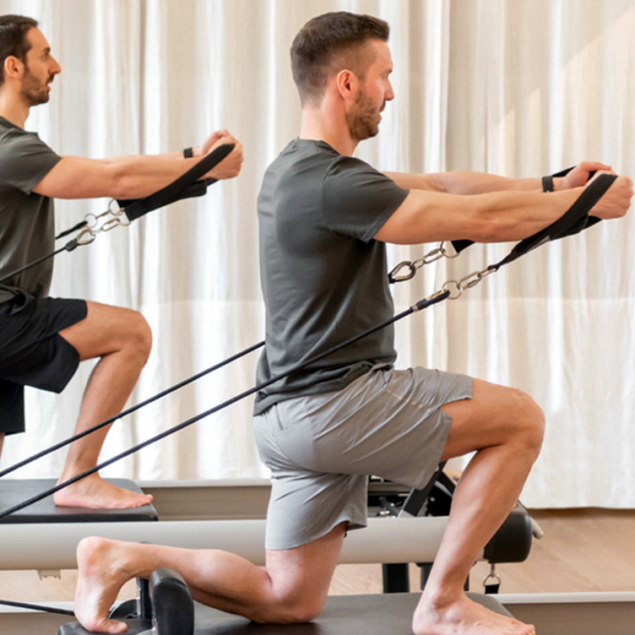
From working up a serious sweat to giving your mind a break from daily responsibilities, everyone enjoys Pilates for different reasons. But beyond improving flexibility, strengthening muscles and enhancing overall well-being, more people are turning to Pilates to ease their way back into a workout routine following an injury.
Pilates is a low-impact exercise focusing on controlled movements. It can be a fantastic workout for those seeking a gentle yet effective way to recover from injuries and restore their physical health. In this blog post, we’ll explore Pilates for rehabilitation and injury recovery, outlining its benefits and moves to get you started.
Whether you are in the early stages of rehabilitation or feel more confident on your feet to try something new, Pilates can do wonders for the body. Here are a few reason’’s to consider Pilates as you work through your recovery:
One key benefit of Pilates for injury recovery is its focus on improving balance and stability. Injuries, particularly those affecting the lower body, can significantly disrupt a person’s sense of balance. Pilates exercises, such as the standing leg lift or the single-leg stretch, target the core muscles and lower body, helping to re-establish balance and prevent future injuries.
By strengthening the muscles that support the spine and pelvis, you can develop a stable foundation for all movements on and off the reformer. Improved balance and stability can aid your recovery and enhance overall physical performance, reducing the likelihood of future injuries.
Poor posture is a common issue that can lead to various musculoskeletal problems, including back pain, neck strain and shoulder injuries. Pilates is all about maintaining perfect alignment and posture, teaching individuals how to hold their bodies correctly during exercises and daily activities.
Movements like the pelvic tilt, chest lift and spine stretch forward work to lengthen and strengthen the spine, promoting better posture. Improved posture not only aids in injury recovery but also helps prevent future injuries by reducing strain on the body. Consistently practising Pilates can lead to a more upright and aligned posture, which can help reduce discomfort in daily life.
Muscular imbalances, where certain muscles are stronger or tighter than others, are a common consequence of injuries. These imbalances can lead to improper movement patterns and increase the risk of re-injury. Pilates for injury rehabilitation exercises are designed to address these imbalances by targeting both the agonist and antagonist muscle groups.
For instance, the side leg series helps to strengthen and stretch the muscles on both sides of the body, promoting balanced muscle development. By correcting these imbalances, Pilates helps restore normal movement patterns and allows you to move more freely throughout the day.
Flexibility is often compromised after an injury, particularly if there has been a period of immobilisation. Pilates incorporates a range of stretching exercises that help improve flexibility and range of motion.
Exercises such as the mermaid stretch and the spine twist gently stretch the muscles and joints, facilitating a gradual return to full mobility. Increased flexibility not only aids in injury recovery but also enhances overall physical performance and reduces the risk of future injuries. Maintaining some level of flexibility is essential for everyday activities and can lead to a more active and comfortable lifestyle.
Given its gentle but effective nature, Pilates encourages practising mind-body connection. Whether you’re working your upper or lower body, each movement requires concentration, control and precision, allowing you to get in touch with how your body moves. This heightened awareness can be particularly beneficial during injury recovery, as it encourages individuals to listen to their bodies and avoid movements that cause pain or discomfort.
High body awareness during your Pilates session can help you recover more effectively as you develop healthier movement patterns. Outside injury rehabilitation, practising mind-body connection also contributes to healthier mental well-being, which can relieve stress.
The effectiveness of Pilates in injury rehabilitation can be further understood by examining specific exercises tailored to different types of injuries.
Once you get into your groove with your new Pilates routine, we recommend incorporating the following to ensure you further enhance the rehabilitation process:
KX Pilates is dedicated to helping you on your journey to recovery. Our highly experienced instructors and inclusive studios provide the perfect environment to support your rehabilitation process. Our class sizes range from 10 to 14 people, giving you the space to receive specialised attention as you recover.
Book a class with KX Pilates today and embrace a challenging but rewarding way to feel strong.